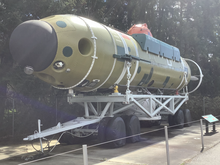DSRV-1 Mystic
 DSRV-1 (Mystic) docked to a Los Angeles-class attack submarine. | |
| History | |
|---|---|
 United States United States | |
| Name |
|
| Namesake | The village of Mystic, Connecticut |
| Builder | Lockheed Missiles and Space Company, Sunnyvale, California |
| Launched | 24 January 1970 |
| Acquired | 1 June 1970 |
| Out of service | 1 October 2008 |
| General characteristics | |
| Class and type | DSRV-1- (Mystic-) class deep submergence rescue vehicle |
| Displacement | 30.5 tons surfaced, 37 tons submerged |
| Length | 49 ft (15 m) |
| Beam | 8 ft (2.4 m); Width 11 ft (3.4 m) |
| Installed power | 15 shaft horsepower (11.2 kilowatt) |
| Propulsion | Electric motors, silver-zinc batteries, one shaft, four thrusters |
| Speed | 4 knots (7.4 km/h; 4.6 mph) |
| Endurance | 30 hours submerged at 3 knots (5.6 km/h) |
| Test depth | 5,000 feet (1,500 m) |
| Capacity | 24 passengers |
| Complement | Four (two pilots and two rescue personnel) |


DSRV-1 Mystic is a deep-submergence rescue vehicle that is rated to dive up to 5,000 feet (1,500 m). It was built by Lockheed for the US Navy at a construction cost of $41 million and launched 24 January 1970.[1] It was declared fully operational in 1977 and named Mystic.[2]

The submarine was intended to be air transportable; it was 50 feet (15 m) long and 8 feet (2.4 m) in diameter, and it weighed 37 tons. The sub was capable of descending to 5,000 feet (1,500 m) below the surface and could carry 24 passengers at a time, in addition to its crew. It was stationed at Naval Air Station North Island in San Diego and was never required to conduct an actual rescue operation. Mystic was replaced by the SRDRS on September 30, 2008, and began deactivation on October 1, 2008.[3] In October 2014, the submarine was donated to the Naval Undersea Museum,[4] and restored in February 2021.[5]
See also
- Mystic-class deep-submergence rescue vehicle – Class of US Navy submersible for rescue operations on submerged, disabled submarines
- DSRV-2 Avalon – Mystic-class deep-submergence rescue vehicle
Awards
- Meritorious Unit Citation with 3 stars (4 awards)
- Navy E Ribbon (3 awards)
- National Defense Service Medal with star (2 awards)
References
 This article includes information collected from the Naval Vessel Register, which, as a U.S. government publication, is in the public domain. The entry can be found here.
This article includes information collected from the Naval Vessel Register, which, as a U.S. government publication, is in the public domain. The entry can be found here.
- ^ Ryan, Mary (2011). "Rescuing Submariners: From DSRVs to the SRDRS" (PDF). Undersea Quarterly. 15 (2). Naval Undersea Museum Foundation: 1–6. Archived from the original (PDF) on 2014-03-25.
- ^ Polmar, Norman (January 15, 2005). Naval Institute Guide to the Ships and Aircraft of the Us Fleet (18 ed.). Naval Institute Press. pp. 95–96. ISBN 9781591146858.
- ^ "Deep Quest" (PDF). Artifact Spotlight. Naval Undersea Museum. Archived from the original (PDF) on 25 March 2014. Retrieved 25 March 2014.
- ^ "Naval Undersea Museum Keyport Opens DSRV Mystic To VIPs". United States Navy. 2015-07-23.
- ^ Farley, Josh (February 22, 2021). "Deep-diving Mystic restored at Navy's undersea museum in Keyport". Kitsap Sun. Retrieved May 12, 2024.
External links
- NavSource Online: Submarine Photo Archive Mystic (DSRV-1)
- USN Factfile DSRV 1 & 2
- Liewer, Steve, "Goodbye To Mystic Minisub, Hello To Falcon", San Diego Union-Tribune, March 6, 2009.
- v
- t
- e
- Mystic (DSRV-1)
- Avalon (DSRV-2)
 | This article about a specific naval submarine of the United States is a stub. You can help Wikipedia by expanding it. |
- v
- t
- e
















